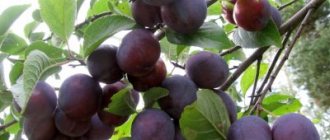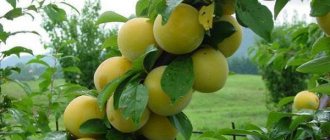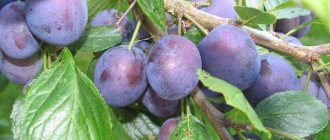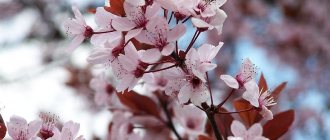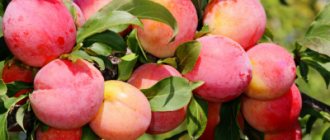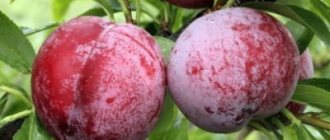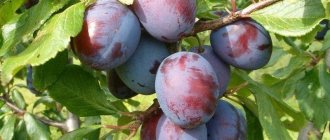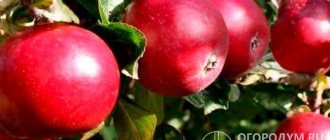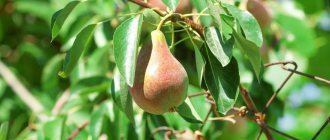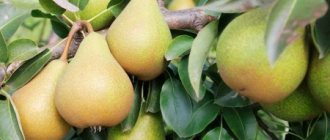Angelina plum (Angelino) is a popular variety that is in demand among many summer residents and gardeners who prefer to grow fruit trees. The article discusses the general characteristics of the plant and fruits and offers step-by-step recommendations for planting and caring for a seedling. Helpful tips on pest and disease control are also provided.
Plum Angelina (Angelino)
Angelina plum fruits have a blue coating
The yield indicators of the “Angelina” variety are consistently high
Description and characteristics of Angelina
The tree can reach a height of three meters. The crown has a pyramidal shape, the base is wide. Formed from powerful, slightly spreading branches. The tree is characterized by medium density of foliage. The leaves are elliptical in shape with a slight point at the apex. The flowers are white, collected in ordinary umbrellas. Flowering occurs in early May and begins a year after planting the tree.
The fruits are barrel-shaped or round, large. Some can weigh around 120 g. The average fruit weight is 60-90 g. The pulp is juicy, sweet and sour, amber in color. The peel is dark purple in color and has a blue coating with a slight silver tint. The bone is small and easily separated.
Angelina plum is a variety characterized by increased resistance to most fungal diseases and pests, and also adapts well to unfavorable environmental conditions.
Advantages and disadvantages
This variety has both advantages and disadvantages, but there are more positive aspects. Among the advantages, gardeners note the following features:
- use of fruits for various purposes;
- good taste and external qualities;
- good yield indicator;
- long shelf life;
- resistance to high and low temperatures.
The disadvantages include average resistance to diseases, difficulty in choosing a pollinator and slow plant growth in the Central Black Earth region.
The gardener reviewed the Angelina plum variety in the video below:
Features of planting a seedling
An important process for each fruit tree, which will subsequently affect its growth and development, is planting. To obtain the maximum amount of harvest with good taste and appearance, the gardener must follow certain recommendations for planting plums of this variety.
Landing requirements
The plant can be planted in both spring and autumn. Be sure to choose a sunny place, protected from the winds. When planting, take into account the thickness of the crown. The soils are desirable loose, fertile.
What crops are best to plant with?
Any tall trees will negatively affect the active growth of the Angelina plum and protect the plant from the penetration of sunlight. This can cause a slowdown in the development of the plant and negatively affect the amount of harvest. Planting apple, pear, raspberry and black currant bushes next to plum trees will have a negative impact on the crop. For the Angelina variety, maple will be the best neighbor.
Preparation of soil and planting material
When purchasing a seedling, be sure to pay attention to the root system: it must be carefully packed in film and fertilized with peat, which provides reliable protection from mechanical damage and moisture loss.
A few weeks before planting, prepare a planting hole 60 cm deep and 70 cm wide. The planting mixture is enriched: add several buckets of organic matter (humus or compost). From mineral fertilizers, take about 400 g of superphosphate. To ensure the stability of the seedling, tie it to a stake stuck in the center of the hole. Water the seedling with four buckets of water.
Step-by-step instructions for planting
The gardener will not have any difficulties when planting a seedling, but following the recommendations will ensure better plant growth. Follow this pattern:
- Dig a hole and inspect it so that the dimensions correspond to the root system of the plant; it should fit freely in the recess.
- Mix fertile soil with organic matter and mineral elements and place the mixture at the bottom of the hole.
- In the center of the recess, form a hill and place a peg in it to support the plant and protect it from gusts of wind.
- Compact the soil and water thoroughly.
- After the moisture has been absorbed, mulch the seedling with sawdust. You can find more information about proper soil mulching here.
- The last stage is to firmly tie the seedling to the support.
We also recommend reading a detailed article on how to plant and grow plum trees.
Features of cultivation and care
Angelino can be planted in both spring and autumn. The plant is a light-loving plant; you need to choose a sunny and cozy place for the seedling. In the shade, wind or draft it will develop slowly.
Due to the voluminous crown, an adult tree will need quite a lot of space; this is also important to consider when planting young trees. This plum is planted at a distance of 5-6 m from other trees so that in the future its large crown does not shade them.
It is better to prepare a hole measuring 60x70 cm a couple of weeks before planting. When planting, it is good to add a bucket of compost or humus, you can add 300-400 grams of superphosphate. It is recommended to bury a peg next to the trunk, to which you can then tie the seedling. The tree must be watered abundantly (3-4 buckets of water).
To speed up fruiting and create a crown, the plum requires summer pruning in the first years after planting.
It is recommended to feed it with ammonium nitrate in the spring, and add potassium salt and superphosphate in the fall.
Soil requirements: neutral or slightly alkaline (pH 6.0 or more). Acidic soil for growing plums will have to be deoxidized with dolomite flour or ash. The plant does not tolerate waterlogged soil well; groundwater should be lower than half a meter from the surface.
In the Central Black Earth region, gardeners encountered difficulties in growing Angelino plums. Due to unsuitable soil, the tree does not bear fruit for long, only 2-3 years. In subsequent years, he suffers greatly from gum disease and dies.
Variety care
Caring for the Angelina plum does not require much time or physical effort. For good growth and development, mandatory measures include watering, fertilizing, pruning trees and preparing for winter.
Watering
The tree requires constant watering. The soil must be saturated with moisture to a depth of 35-40 cm. At the beginning of summer, more stable watering is required - about 5-6 buckets of water per plant. But you should not flood the tree, since excess moisture can cause the development of fungal diseases.
Fertilizer
Until the plant turns 5 years old, feed it according to the following scheme:
- In the spring. Add 40 g of ammonium nitrate per 1 sq. m.
- In autumn. Fertilize the plant with 40 g of potassium salt and 80 g of superphosphate per 1 square meter. m.
Fertilize every other year. For adult plants, follow the same scheme, but double the amount of fertilizing. Apply organic fertilizers every three years: one bucket of humus.
Tree pruning
Young trees require constant pruning in the summer - this helps speed up fruiting. Already mature plants will need formative pruning, which is considered an easy type of such procedure.
During pruning, the gardener will be able to thin out the crown to avoid thickening, and trim the main ones to stimulate the growth of growing branches. During the fruiting period, be sure to remove diseased, deformed and broken branches. Carry out sanitary pruning every fall.
Anti-aging pruning is carried out only during the period when it is clear that growth has slowed down and the plant produces a small amount of harvest. During the procedure, remove branches that have grown over 3-4 years. Further pruning is carried out after 4-5 years.
Preparing for winter
Preparing for winter begins with compacting the soil around the tree well. If necessary, you can water the plant and fertilize it. They also paint the tree trunk with lime to avoid damage from severe frosts, spring frosts and severe temperature changes. Mulch the plant with humus. After the snow falls, form a snowdrift around the tree.
Wrap young plants with burlap or agrofibre - this will provide reliable protection not only from frost, but also from rodents.
Diseases, pests, treatment and prevention
The Angelina plum variety is characterized by high resistance to weather changes and low maintenance requirements, but has average resistance to various diseases and pests that can negatively affect yields.
To avoid this, read about prevention and treatment:
| Disease/Pest | Symptoms | Treatment/Prevention |
| Fruit rot | Dark spots form on the fruits, gradually spreading to all fruits. | For prevention, do not allow mechanical damage to the fruits; spray them with iodine solution every three days. To combat the disease, collect all affected fruits and burn them. |
| Rust | Brown spots with a rusty tint form between the leaf veins. By autumn the spots become darker. | Fungicides that are applied to problem areas will help fight the disease. For prevention, treat the seeds with fungicides before planting or make layering exclusively from healthy plants. Feed trees with microelements. |
| Chlorotic ringspot | Yellow rings and stripes appear on the leaves, and the fruits become covered with dark spots. | As a preventative measure, remove weeds and use healthy planting materials. To combat the disease, it is necessary to carry out disinfection only in special laboratory conditions. |
| Plum sawfly | At the beginning of summer, the upper side of the leaves becomes covered with small brown spots, and a powdery pink coating appears on the lower part. | Burning the damaged parts of the plant will help eliminate the pest. For prevention, regularly loosen the soil and water the tree abundantly during the flowering period. |
| Plum moth | Caterpillars feed on the pulp of fruits, destroying and polluting them with their excrement. This leads to premature ripening of fruits and their falling off. | Prevention consists of timely cleaning of the area from fallen plums and loosening the soil. Control measures are as follows: clear the tree of dead bark and remove the affected fruits. Use a chemical sprayer. |
| Cane aphid | When aphids settle in dense colonies on the lower surface of leaves, the pest causes significant damage to the plant. The edges of the leaves curl down and become discolored along the veins. Young fruits infested with aphids are deformed and do not ripen completely. | To get rid of the pest, spray the crown with pyrethroids, insecticides that include nicotine, or mineral oils. |
You can see a complete overview of plum diseases and learn about methods of treating them from our other article, which is located here. Timely elimination of the problem will have a positive effect on the quality and quantity of the harvest.
What is Angelino's illness?
With increased frost resistance, trees of this variety tolerate frosts down to -30°C well, and their resistance to pests is average. Most often, plums are subject to the following diseases:
Hole spot
The fungus affects branches, leaves, and inflorescences. Brown spots with dark edges are visually visible. The leaves are covered with small holes.
The surface of the fruit is deformed, they do not grow and remain small. Most often, trees get sick in the spring, during periods of frequent rains. A thickened crown contributes to the development of the disease.
Therefore, for prevention, the plum crown must be thinned annually, fallen leaves must be removed from under the tree in the fall, and the soil under it must be dug up. If the disease does appear, a couple of weeks after flowering, the tree should be sprayed with Bordeaux mixture (1%) or copper oxychloride. Usually take 30-40 grams of active substance per 10 liters of water.
Gum treatment
Visually, the disease looks like a clot of colorless or brownish resin on a branch or tree trunk. Occurs at the site of a cut or at the site of a sunburn. The cause of the disease is a high nitrogen content in the soil or waterlogging of the soil.
The affected plant dries out. Prevention of gum disease - careful and careful care of the tree, avoiding injuries and damage to branches. If resin appears, the area must be cleaned, wiped with a solution of copper sulfate (1%), and applied with garden pitch or petrolatum. In advanced cases, it is better to cut off branches with lesions.
Rust
Characteristic signs of the disease are voluminous round brown spots on the outside of the leaves, very similar to rust.
The affected tree weakens, leaves fall off, frost resistance decreases, and there is a risk that the tree will die in winter. In the fight against rust, spraying with a solution of copper chloride (40 g per 5 liters of water) is effective.
Spray generously, per tree - 3 liters of solution. Treatment should be carried out before flowering. And in the fall, after removing the fruits, you need to spray it with a one percent solution of Bordeaux mixture. Remove fallen leaves and burn.
Fruit rot (miniliosis)
The fungal disease progresses during rainy summers. Brown spots appear on the fruits and leaves, which are then covered with white growths containing fungal spores.
The rot spreads quite quickly. The difficulty of combating it lies in the fact that fungi are resistant to frost; many means of prevention and treatment are powerless.
Rot primarily affects mechanically damaged plums (by birds, hail, garden tools). Therefore, to avoid rotting, the fruits must be removed immediately. Promotes the appearance of moniliosis scab. It is important to protect trees from it.
Plum sawfly, codling moth, and cane aphid are the most dangerous pests for plums. These parasites need to be recognized and dealt with in time.
Collection and storage
Harvest occurs at the end of September. This variety is characterized by high keeping quality. Plums can be stored for about three weeks at room temperature. When stored in the refrigerator, the period increases to four months. At the same time, the taste and external qualities of the fruit do not change.
Let's allow the collection of unripe fruits. This way they will ripen in the refrigerator and their taste will be better.
Usage
The fruits are widely used due to their taste and unique property of being stored for a long time:
- Plums are good fresh. Their appearance always whets the appetite.
- The fruits are frozen in order to enjoy their taste during the cold season, which is preserved in them as well as all the beneficial properties.
- Plums are used for preparations for the winter; jams, jams, and compotes are made from them.
- The fruits are dried to obtain dried fruits.
Read also: Early cucumbers in an unheated greenhouse: video varieties
Reviews from gardeners
Most gardeners speak positively about the Angelina plum variety, citing its unpretentiousness and low maintenance requirements.
★★★★★
Nadezhda, 36 years old, a beginner gardener. Several years ago I bought my own house and thought for a long time about what to initially plant on the plot next to it.
I heard from friends about the Angelina plum, and I had no doubts. I bought a seedling, and within a few years large fruits began to form on the tree, pleasing not only with their appearance, but also with their sweet and sour taste. I make jam and preserves from plums. ★★★★★
Ivan, 62 years old, experienced gardener. I have been growing Angelina plums for many years.
I have a lot of trees on my property. I sell seedlings. Initially, I was attracted by the high yield; I like the plant during the flowering period. For me, the plum is a source of income, undemanding and resistant to weather changes. ★★★★★
Valery, 41 years old, summer resident. I planted several plums of this variety on my summer cottage, and there are two maples growing nearby.
I like that Angelina is easy to grow and requires minimal care: watering, loosening the soil, and fertilizing several times a year. My family and I like the taste of fruits - they are sweet and sour and not cloying. Hide
Add your review
Angelina plum is a plant that is chosen by many gardeners who are convinced of its undemanding cultivation and care. Following the recommendations for planting seedlings will ensure good growth and development of the plant and increase productivity.
0
0
Copy link
Reviews of the plum variety Angelina
The Angelina plum is known all over the world. It has a good taste, is easy to grow, and therefore gardeners rarely speak badly of it.
- Oleg Puzik : “I was never a fan of plums, because in childhood all my relatives only grew up Hungarian. But as soon as I tried the Angelina Plum, I decided that it would live in my garden for a long time. The fruits are fleshy, very juicy, and the seed is small. The peel cracks only after it is overripe, and only if you press it down, so I collect it a little ahead of time, so it lasts longer. My wife makes delicious compotes and jams from this plum - in general, I think that this is the most interesting and best variety to grow for yourself.”
- Alexandra Golenko : “My Angelina plum tree is often affected by caterpillars, but if you care for it properly, the fruits will not be damaged. The trees are not difficult to care for; the harvests are large. Most of the fruit is used for sale; the rest of the cream is canned and eaten fresh. The variety is excellent for eating, juicy, sweet, and practically not sour.”
- Sergey Dashko : “For our family, plums are more a source of income than a favorite delicacy, although we close the jam every year. The Angelina variety was chosen for its yield, taste, appearance of the fruit and high demand. It is sold on an equal basis with other varieties at a high price. The trees require care, but they bear fruit as they should, so there are no complaints. I can recommend the variety for those who sell plums.”

